Local marketing is everywhere around us as consumers. Even when we’re not searching for something specific, the search engines still show us relevant local results anyway. As a business owner, you can capitalize on this to bring more customers to you.
With local marketing, you’re working to optimize your website and advertising, both online and offline, to grow word-of-mouth and drive foot traffic and brand awareness within your local service area.
More than 80% of shoppers who visited a store in the last week (as of February 2019) say they’d used an online search before going into a store. That means if people don’t find you online, chances are they’re going to your competitor.

If your business targets a local audience, has a brick-and-mortar location, or provides products or services in multiple areas, you cannot afford to ignore local marketing. In this guide, we cover the basics of local marketing and break down various strategies to help you get started.
What is Local Marketing?
Local marketing is a strategy focused on targeting customers within a certain geographic radius from a business’ physical location – whether it is a locally owned business or part of a chain. You may also hear it referred to as “local store marketing” or “neighborhood marketing.”
For companies with at least one brick-and-mortar location, local marketing is a crucial part of bringing in new customers. For businesses that rely on in-person transactions, it is absolutely essential. Local marketing directs your resources to specific customers most likely to shop with you.
Successful local marketing begins with accurate buyer personas. The process ensures you understand your target demographic and psychographic information, including where they live and work. The location information pinpoints where you focus your marketing efforts.
Chapter 1: How to Get More Leads From Google Business Profile

Building a website or having a Twitter account isn’t enough to get new leads. Fortunately, Google gives businesses plenty of tools to help.
What is Google Business Profile?
Google Business Profile (GBP) is a free tool for small business owners. It helps manage your online presence across all of Google – from Search to Maps. After signing up, you can verify your business and take control of its profile on Google.
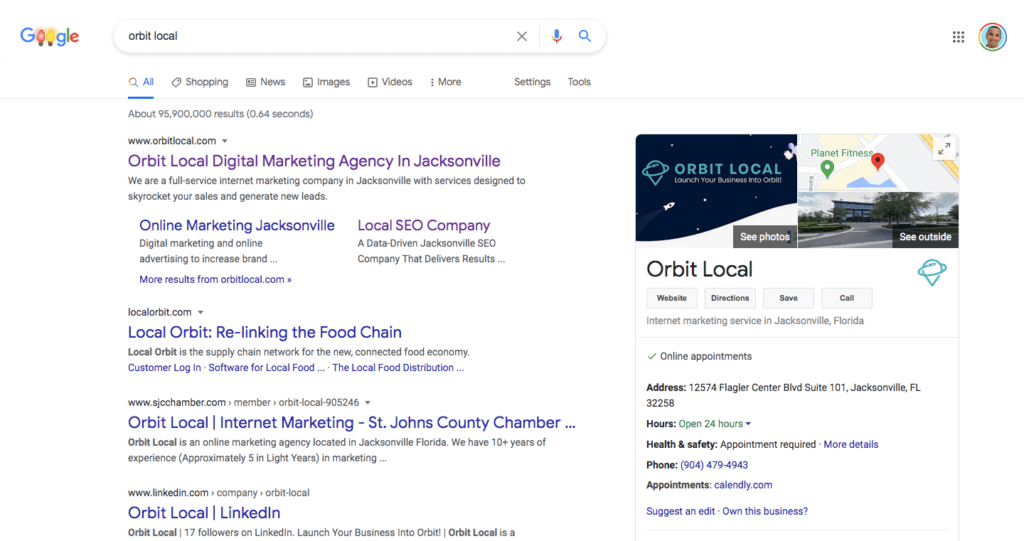
It’s more than a free business listing. Creating a business profile is the same thing as adding a place to Google Maps. Anyone can do it. After Google confirms it is an original listing, they will create a business profile. The profile is what lets people add reviews, photos, and answer questions. The profile may populate with information that the search engine gathers from across the web.
Your business profile can exist on its own – without a GMB account. If someone else has created the profile for your business, you can attach a GMB account to it. Once you verify business ownership, Google will give you control over the profile, where you will be able to adjust what people see when they find you in the results. To get started, visit Google Business Profile and sign into (or create) your Google account. Follow the steps on screen to complete.
How to Rank in Google Maps
To rank in Google Maps, it’s important to remember that local results favor relevant results for each search. Google considers relevance, distance, and prominence in their ranking. Prominence refers to how well the small businesses are known, so famous museums, well-known store brands, and landmark hotels are more likely to be prominent in the search results. Prominence however is also based on the information Google has about a business from across the web. your review count and review score also factored into the search ranking.
Claim and Verify Your Profile
- Login to Google Business Profile.
- Search to see if your business already has a profile. Follow the steps to claim your listing.
- Verify your business.
- On your computer, choose the business you’d like to verify.
- Click the Verify now button. You’ll be requesting a postcard from Google, so make sure your address is correctly displayed.
- Click Send Postcard. Most will arrive within 14 days.
- After you receive your postcard, login to Google Business Profile. Open the location you’re verifying (if you have multiple locations.) and click Verify now.
- In the “Code” field, enter the five digit code from your postcard.
Instructions vary slightly if you’re using the Google Business Profile app on your mobile device.
- Open the app.
- Tap Send a postcard.
- Tap the business you’d like to verify.
- Tap I don’t have a code to request your postcard.
- Once the card arrives, open the Google Business Profile App.
- Choose the business you want to verify.
- To verify, tap Enter code and enter the five digit code shown on your postcard.
If you’ve already verified your business with the Google Search Console, you may be able to verify your business instantly. Some businesses may be eligible to verify by phone or email. Those that are will see the options in their account.
Optimize Your Profile
The more information you provide about your business, the easier it will be for Google to match your business to relevant search results.
When you add your name, address, and phone number (NAP), pay attention to exactly how you list it. This is crucial when it comes to building local SEO citations, which we’ll go into more detail about later in this article.
Choose your categories carefully. You can choose up to 10 categories, but the primary category is thought to have the greatest influence on your ranking. How should you choose your categories?
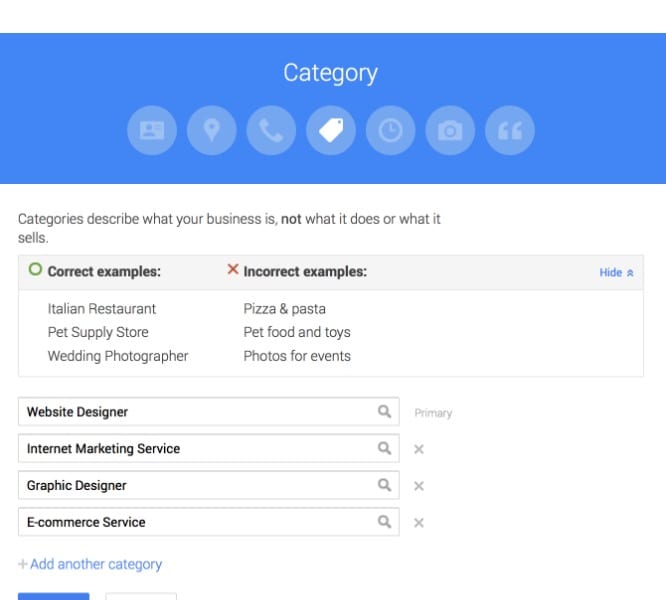
- Determine your most important search phrases. Create a list with the type of business you operate and its variants. Also include the list of goods or services you offer.
- Enter your list of keywords into keyword research tools to determine the ones with the highest potential search volume. Note the search volume for each term in your list.
- Refine the list down to a smaller list of terms that combine the highest search volume with the ones that are most relevant and important to your company. You can target lower search volume phrases that are closer to an exact description of what your business is or are less competitive.
- Search those phrases for your local market. Make a list of all the competitors in your market.
- Using the Chrome browser, download the GMBSpy extension. This allows you to go into Google Maps, search for your competitors, and see the categories they are using. Note all the categories your competition is using, with special attention on the categories businesses that are ranking #1 for each of your search phrases.
- Use PlePer Google Business Profile Category Helper to get suggestions of categories to add.
Complete your profile 100%. The more information you provide to Google about your business, the better. This includes adding photos of your storefront, products/services, etc. Beyond photos, add your business hours so searchers know when you’re open. Make updates as these change for holidays to keep the information current and accurate.
Generate Reviews
There are several ways to build more Google reviews, including:
- Asking customers directly to leave a review.
- Send follow up emails asking for a review.
- Leave a business card after you’ve finished a job (ideal for contractors and local service companies) with information about leaving a Google review.
- Add a review link to your website.
- Use a review generation tool to streamline the review process for your customers.
- Add calls to action and popups on your website.
Respond to Reviews
Take time to manage and respond to customer reviews that users leave about your business. Replying to reviews shows that you value your customers and their feedback. High quality and positive online reviews from your customers can help improve your business visibility while also increasing the likelihood that a shopper will visit your location.
While it may be tempting to only respond to positive reviews, it’s crucial to respond to negative ones, too. Politely thank them for taking the time to leave the review, apologize for the issue, and provide a way for them to contact you off the platform – either email or phone. Work with the reviewer to address their issue.
Regularly Update Your Profile
Make it a point to check in on your GMB profile at least once a quarter. If you have changes in products or services or business hours, you should change them as soon as possible. You can also add posts and offers your profile to keep content fresh.
A search for Jacksonville Plumbers puts Best Jacksonville Plumbers at the top of the list. Their GMB profile contains their address, hours, phone number, photos, customer reviews, and ratings.
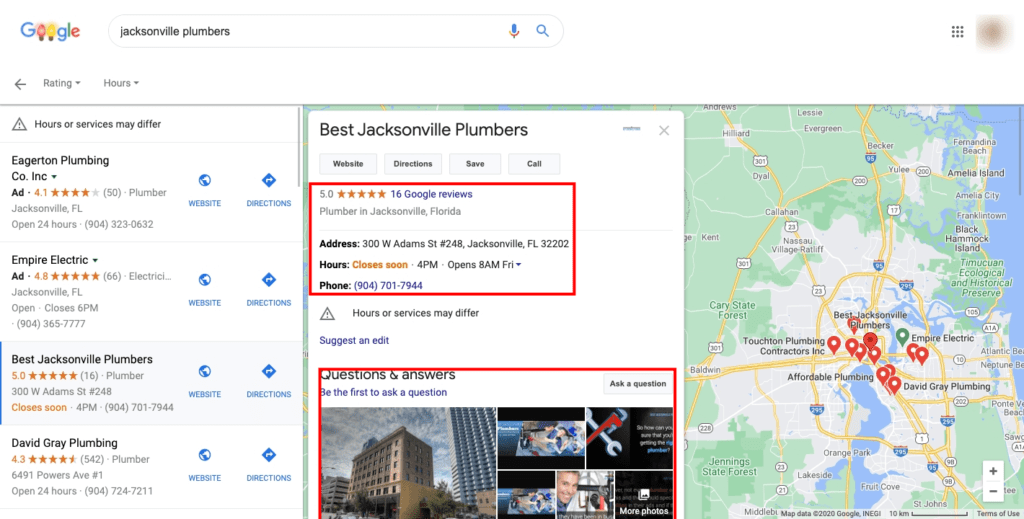
Google Business Profile Resources
- Google: Google Business Profile
- Assistant: All you need to know to rank on Google Maps
- SEJ: A Complete Guide to Google Maps Marketing
- Simpli Learn: 11 Conventional local SEO tips to rule google maps
- YEAH Local: How to Optimize Google Business Profile (to get leads)
- Startup Nation: A Step-by-Step Guide to Generating Local Leads with Google Business Profile
Chapter 2: Optimizing your Business Website for Conversions

You can build a stunning website that ranks well, but if people aren’t taking the desired action on your website, then it provides no value to you. Traffic is only part of the digital marketing equation.
What is Conversion Rate Optimization?
Conversion rate optimization (CRO) is the systemic approach to increasing the amount of traffic to your website that takes action. Whether that action is to sign up for your email list, schedule a consultation, or make a purchase – the website visitor is converting.
In CRO, you look at how people move through your website, what they are doing, and what is stopping them from completing your goals.
Using analytics data and feedback from your site visitors, you can determine what areas of your website need to be optimized and what exactly you need to do for optimization.
How to Track Leads and Calls
Investing in call tracking software allows you to quickly and easily track calls from each of your marketing campaigns. You create custom phone numbers unique for each In addition to the conversion data, call tracking software allows you to listen to calls so you can identify opportunities to help you improve customer service.
Here at Orbit Local, we use WhatConverts because it does more than track phone calls. It also tracks chats, web forms, and ecommerce to provide our clients with even more conversion data.
- Sign up for your free two week trial.
- Add the tracking code from the WhatConverts dashboard to your website.
- Choose the web forms on your site you want to track.
- Match your tracking numbers to marketing sources so you can start capturing calls.
- Create events in Google Analytics using clicks from WhatConverts.
- From within your WhatConverts account, select the Integration menu item, then “Google Analytics.”
- Add your Google Analytics tracking ID. This allows WhatConverts to send events based on leads tracked to the account. To get your tracking ID:
- Login to your Google Analytics account
- Click the Admin tab at the top to make sure the correct Account and Property are selected.
- Click on Tracking Info and select Tracking Code. Copy and paste the Tracking ID into WhatConverts.
- Choose what Leads to send to Google Analytics under “Lead Types to Track.”
Once WhatConverts is integrated with Google Analytics, we can see which keywords are driving calls, so we can optimize your campaign based on that data.

Conversion Rate Optimization Resources
- Business 2 Community: Why Your Small Business Needs Conversion Rate Optimization
- Crazy Egg: What is Conversion Rate Optimization (CRO)?
- Heap: Conversion Rate Optimization for Marketing & Product Teams
- SalesForce: Step Up Your Conversion Game: Is Your Website Properly Optimized?
- Shopify: The Beginner’s Guide to Conversion Rate Optimization
- Small Business Computing: Conversion Rate Optimization for Small Business
- VWO: Conversion Rate Optimization
Chapter 3: Google Ads for Local Businesses

Want to be visible in the search engines and drive traffic to your site while you’re still working on improving your rank? Advertise.
What are Google Ads?
Whenever you search for something on Google, you’ll see a few listings at the top before the actual results start. These are ads that companies have paid to have displayed. The idea is that instead of scrolling through the search results that people will click those ads first since they’re at the top of the screen.
Google Ads goes beyond search results pages to allow you to advertise on the Google Display Network, use remarketing campaigns to capture people who’ve visited your website on other platforms, and video ads.
The Google Display Network helps you reach people with targeted ads while they’re visiting websites, watching YouTube videos, checking their Gmail account, or using apps on their mobile devices.
As a business owner, you’ll pay for the ads that are shown across Google (if you pay by impressions) or pay when someone clicks on you ad (if you’re paying by the click.)
How to Use Google Ads Extensions for Better Conversions
Driving sales with Google Ads is about more than targeting based on geolocation. Though targeting potential customers within a specific geographic radius around your physical location is a good place to start, you can include Ad extensions as a more fine-tuned tactic. These extensions expand your ad to provide additional information which ultimately gives people additional reasons to choose your business. Using an extension helps boost your ad’s click-through rate and can go a long way toward bringing in more foot traffic.

Call Extensions
Google data shows local searches are dominated by mobile devices. It makes sense because people are likely out looking for something to do or trying to find a store. It’s still common practice to call a business for more information. If you have a staff available that can always answer the phone, adding the phone extension helps to generate more traffic. Doing so makes it possible for users to click to call your company.
Adding these to your campaigns is easy.
- In your Google Ads dashboard, visit the Extensions tab.
- Click “ Call extension.” Once enabled, users will see your phone number on your ad. If desired, they can click the number to automatically call you.

In a quick search for Jacksonville plumbers, the two ads are both using the Call extension. One of the two uses the Location extension, and the other uses the Callout extension to provide a message about getting a quote.

Google Ads Resources
- Google: Local Service Ads
- ACQUISIO: 7 Ways to Use Google Ads for Local Businesses
- AdExchanger: Google Prioritizes Local Businesses With New Ad Tools
- Keap: How to Use Google AdWords for Your Business (Beginner’s Guide)
- Keap: Google AdWords tips for small businesses
- SpyFu: Small Businesses can Benefit from Google Ads
Chapter 4: Local SEO

With a local SEO, whether that’s law firm SEO or plumber SEO campaigns, you are aiming to increase the visibility of your brick-and-mortar business within the search engine results page for local service-based intent searches. The higher your search engine rankings, the more likely you are to bring in more local customers.
Local SEO involves:
- Conducting keyword research to find the phrases people are searching that are relevant to your business.
- Creating local SEO citations for your business.
- On-Page SEO: Including local keywords where appropriate throughout your website, especially title tags and URLs.
- Content marketing: Creating and promoting a useful local resource. For example, a local landscaping company could create a resource on plant care.
- Link building: Creating links to your website from other relevant, high-quality websites.
- Generating customer reviews
- Publishing new content on a regular basis
What are Local SEO Citations?
Citations are online references to a business that features the business name, address, and phone number (N.A.P.) Every time you list your business on a site like Yelp or another business directory, you’re creating a new citation. For best results, use the same business name, address, and phone number across all listings. It’s also a good idea to use the same categories across all the websites you list your business in, where possible. Variations in the information may affect how Google interprets the data.
How to Track Citation Status
There are a number of citation management tools on the market today, and the right one comes down to your budget and needs. Things to consider include:
- Does it allow for you to pick certain directories or does it make the choice for you?
- Does it have to choose industry-specific directories?
- Does the tool use aggregators or a direct API to the directories?
- How accurate is the duplicate detection?
- How does it compare to other tools with the same features?
- Does the price per location fall in line with my budget?
The tools with open APIs with directories help keep citations live. Sometimes though, your business can lose citations for a number of reasons. If your tool doesn’t track citations, you’ll need to use a third-party tool to keep an eye on the status of the citations to ensure they stay live.
Local SEO Resources
- Status Brew: How to Rank your Local Business Higher on Google + [Infographic]
- Word Tracker: Improve your local SEO with these citation essentials
- Ahrefs: How to Build Local Citations (Complete Guide)
- Bright Local: Local SEO: The Complete Guide
- Wordstream: Top 10 Ways to Improve Your Local SEO Right Now
Chapter 5: Social Media Marketing

Social media marketing is a crucial part of any marketing strategy, but when implemented correctly, it can work for local marketing, too.
What is Social Media Marketing?
When business owners use this marketing strategy, they rely on social media platforms like Facebook, YouTube, Twitter, Instagram, Pinterest, and Snapchat (to name a few) to connect with your audience. Small businesses use social media to build brand awareness, increase website traffic, drive sales, and more.
How to Choose Where to Advertise
The idea that a business has to be “everywhere” on social media to be successful is flawed. It’s far better to do one or two platforms exceptionally well than it is to do more than that with mediocre effort. If you’re running a business that primarily targets Baby Boomers, then it doesn’t make sense to spend a lot of time and effort on Snapchat marketing.
Where is the bulk of your audience most active on social media? Sure, your customers may be on Facebook and Twitter, and a slew of others – but if they haven’t looked at their Twitter feeds in months, or years, do you really want to spend money trying to reach them there?
Look at Website Analytics
Your website analytics can provide information about which social channels are driving traffic to your website. If you’re running a campaign and finding that it’s not driving as much traffic as you’d like, then you know it may be worth adjusting your approach.
Use Social Listening Tools
This helps you analyze your current followers, so you can learn more about your current audience to decide whether you want to keep investing in that platform.
If you haven’t established a social media presence yet, or you want to learn more about platforms you’ve not explored yet, the Pew Research Center has key demographics information for many of the most popular social media platforms. Base your decisions on demographic data, not current trends.
Look at What Your Competitors are Doing
If your competition is using a social media channel successfully, you could be missing out if you’re not also using that platform. Examining your competition on social cna help you get a baseline on industry activity and guide what you should be doing. Social listening tools can help with your competitive analysis, too.
Social Media Marketing Resources
- Orbit Local: 23 Social Media Post Ideas for Small Businesses
- Hootsuite: How to Use Social Media for Small Business: 11 Simple Tips
- Business News Daily: Social Media for Business: A Marketer’s Guide
- Cox Blue: 17 Tips For Getting Your Small Business Started With Social Media Marketing
- Five Stars: The art & science of social media marketing for small business
- Grasshopper: Using Social Media Outlets for Exposure and Local Advertising
- Money Crushers: 4 Free Social Media Marketing Sites for Local Small Businesses
- National Pen: Social Media Tips for Small Businesses
- Post Planner: 8 Ways to Use Social Media to Grow Your Small Business
- Social Sprout: How to Create a B2B Social Media Strategy (Without Being Boring)
- Vendasta: [Checklist] Local Social Media Marketing: How to Kill It
- Capterra: 6 Best Social Media Marketing Tips for Small Businesses
Chapter 6: Facebook Advertising for Local Business

According to Facebook’s official investor relations information, 3.21 billion people actively use Facebook, Instagram, WhatsApp, or Messenger every month. Globally, there are more than 2.74 billion monthly active users representing a 12% increase year-over-year. What this means is that Facebook is simply too big to ignore if you are a local business seeking new customers. Chances are, various competitors in your local community are already using it as a way to get to potential customers.
What is Facebook Advertising?
Facebook advertising is paying for messages from your business to be displayed to people who fit your target audience. As an Advertiser, you create campaigns with specific goals. You can run ads to get more likes on your pages, drive traffic to your website, and more. You can pay when these ads are clicked, or when the ads are shown to a target audience member.
Local Awareness Ads is an ideal option for business pages with multiple store locations so that information from each of your pages is added to dynamic ad copy that’s localized for each corresponding store. This way, you can advertise across multiple location pages without a lot of extra effort.

How to Create a Facebook Ad Campaign
- Create a campaign in Ads Manager.
- Select the campaign objective.
- Enter a name for the campaign. Click continue.
- Set your audience.

- Set your ad locations. You can add locations in bulk for multiple stores.

- Enter the targeting details you want to use.
- Choose your placements.
- Set your budget and schedule.
- Select Show Advanced Options to set the Optimization for Ad Delivery.
- Set your Frequency Cap to limit the number of times the same people see your ad and how often.

- Choose Automatic or set your bid amount manually.
- Select Continue.
- Choose your format.
- If you want a map card with directions to your business, you’ll need to choose the carousel format. Then, go to Images and check the box for “Add map card with page location.”
- Fill in the text, headline, and destination URL. Add a call to action button, if desired.
- Click Confirm when you’re ready to publish.
Facebook Marketing Resources
- Zen Media: Top 10 Ways to Use Facebook to Promote your Business for Free
- Social Media Examiner: Facebook Ads for Local Businesses: A Framework for More Revenue
- Sign Post: How To Create and Claim a Facebook Page for Your Local Business
- Modern Retail: How neighborhood Facebook groups became havens for ultra-local businesses
- Instapage: Facebook Local Awareness Ads 101: How to Improve Your Reach & Get More Customers Starting Today (6 Examples)
- Agora Pulse: How to Use Local Awareness Ads to Promote Your Business on Facebook
- Active Campaign: What You Need to Know Before You Start Facebook Ads for Small Business
Chapter 7: Local Advertising and Sponsorships

Reach your local audience offline, too. Run ads in publications in your local area. Talk to your chamber of commerce. Buy an ad in the local school yearbook. Sponsor a little league baseball team. Look for local events you can have a booth or tent at.
Local Advertising and Sponsorship Opportunities
The great thing about local advertising and sponsorships is that there are plenty of ways to create packages that work for you. From inclusions in press releases to links on websites or in an email newsletter, logos on shirts or signage at a local event, and media spots, you can get creative and find something that works for your budget.
Local Marketing Tactics
- Radio Ads: Consider running ads on your local radio station. You can also turn to satellite radio and online streaming platforms like Spotify, Pandora, and iHeartRadio.
- Billboards: Billboard advertising is an option to reach customers outside of their home. The cost varies widely, depending on the location of the billboard and the traffic around the area.
- Direct Mail: 73% of American consumers say they prefer being contacted by brands via direct mail because they can read it whenever they want. Send a postcard with “free cash” to spend in your store, or a discount code.
- Build a Loyalty Program: To encourage repeat customers, start a loyalty program. Customers can earn points for every dollar they spend in your store, earn free product after a certain number of purchases, etc.
- Flyers and Business Cards: Post flyers or leave business cards advertising your business in public areas where your ideal customers are likely to see them, like on community bulletin boards.
- TV Ads / Local TV Spot: Consider running TV ads in your local area. Alternatively, work to book a spot on your local news or other relevant program. For instance, restaurant owners could appear on cooking segments on the local noon news.
- Partnerships with Other Businesses: Restaurant owners could partner with local farmers for fresh ingredients. Local farmers could band together to create a farmer’s market. Hair salons could partner with nail technicians to create a one-stop-shop for head to toe beauty.
How to Sponsor Community Events
You can use a tool like Link Prospector to find local sponsorship opportunities, but if you’re going smaller, it is just as easy to browse on your own. Advanced search operators make it easy to find web pages indicating available sponsorship opportunities. Try:
- inurl:sponsors/intitle:sponsors
- inurl:donors/intitle:donors
- inurl:fest/intitle:fest
- inurl:association/intitle:association
You can get more specific, if you want, isolating local PTA organizations with inurl:pta.
Here’s how a search for sponsorships in Jacksonville looks, using this method.
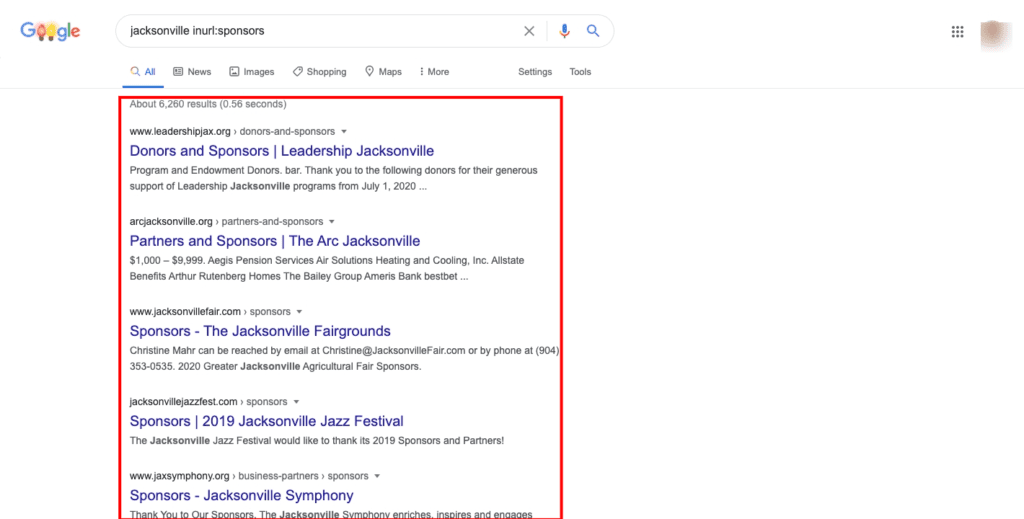
Local Advertising and Sponsorship Resources
- Convince & Convert: How to Make Marketing Sponsorships Work
- Post Planner:This PR Hacker’s 10 Tips Will Probably Get Your Brand Mentioned on CNN
- Loomly:Local Marketing: How to Reach Customers in Your Area
- Startup Grind: The Most Valuable Business Channel You’re Ignoring: Sponsorship Marketing
- Free Agent:9 inexpensive marketing ideas for your small business
- Tutsplus: 30 Budget-Friendly Marketing Ideas: For Your New Small Business
- Business Know-How: 36 Marketing Ideas for Small Business
- Creative Bloom: 100 inspiring ideas to market your business
- Biteable: 40 free advertising ideas that are sneaky but brilliant
Common Questions About Small Business Marketing
Does my website need a blog?
You don’t technically need a blog, as long as you have plenty of informational content to attract customers throughout all levels of their buying process. It helps to establish expertise and authority, while also giving you a chance to rank for another set of u003ca href=u0022https://www.orbitlocal.com/resources/negative-keyword-list/u0022u003ekeywordsu003c/au003e. What matters is that you have more than service pages.
When is the best time to post on social media?
The answer depends on the network you’re posting on, the type of content you’re posting, and ultimately, your own personal audience. Social media analytics tools provide information about the times of day and days of the week when your audience is most active. You can use that starting point and experiment.
What metrics should I use to track my success?
This, too, largely depends on your business and your specific goals. If you’re trying to increase the number of followers on your Facebook page or Twitter account, then metrics like Page Likes and Followers matter. But, if you want to increase engagement with your following, things like the number of comments, replies, or re-tweets matter. u003cbru003eWhen you set your marketing goals, we’ll help you determine the metrics that matter.
Marketing Your Local Business
Effective local marketing can be overwhelming, but it doesn’t have to be. Depending on your location and industry you may have more competition, but with the right marketing strategies, you can dominate local search.
Today, the more marketing channels you have, the better you can reach your customers – but you must adjust your marketing strategy accordingly. No two marketing channels are the same, and treating them the same won’t help you reach consumers effectively.
Developing local marketing strategies is what we do best. Our marketing agency goes beyond basic local online marketing to help you truly reach customers in your community. Today’s consumers demand more than ever, and we’re ready to help you meet those demands.
Ready to supercharge your search engine optimization and marketing strategy to reach more consumers in our local community? Reach out to Orbit Local today!
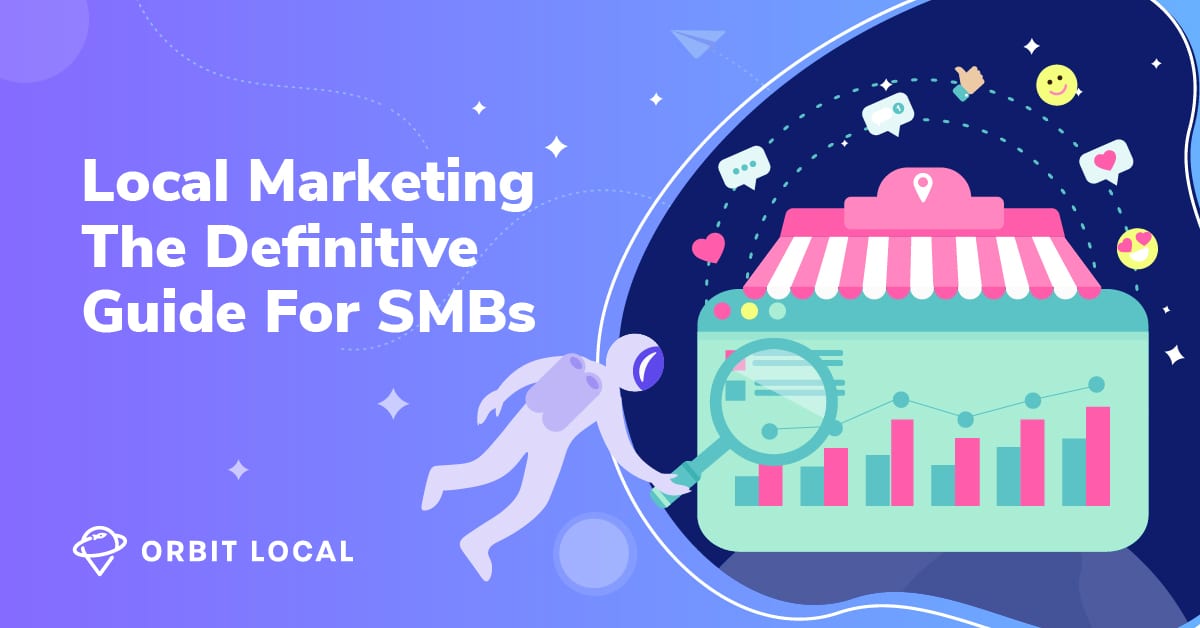
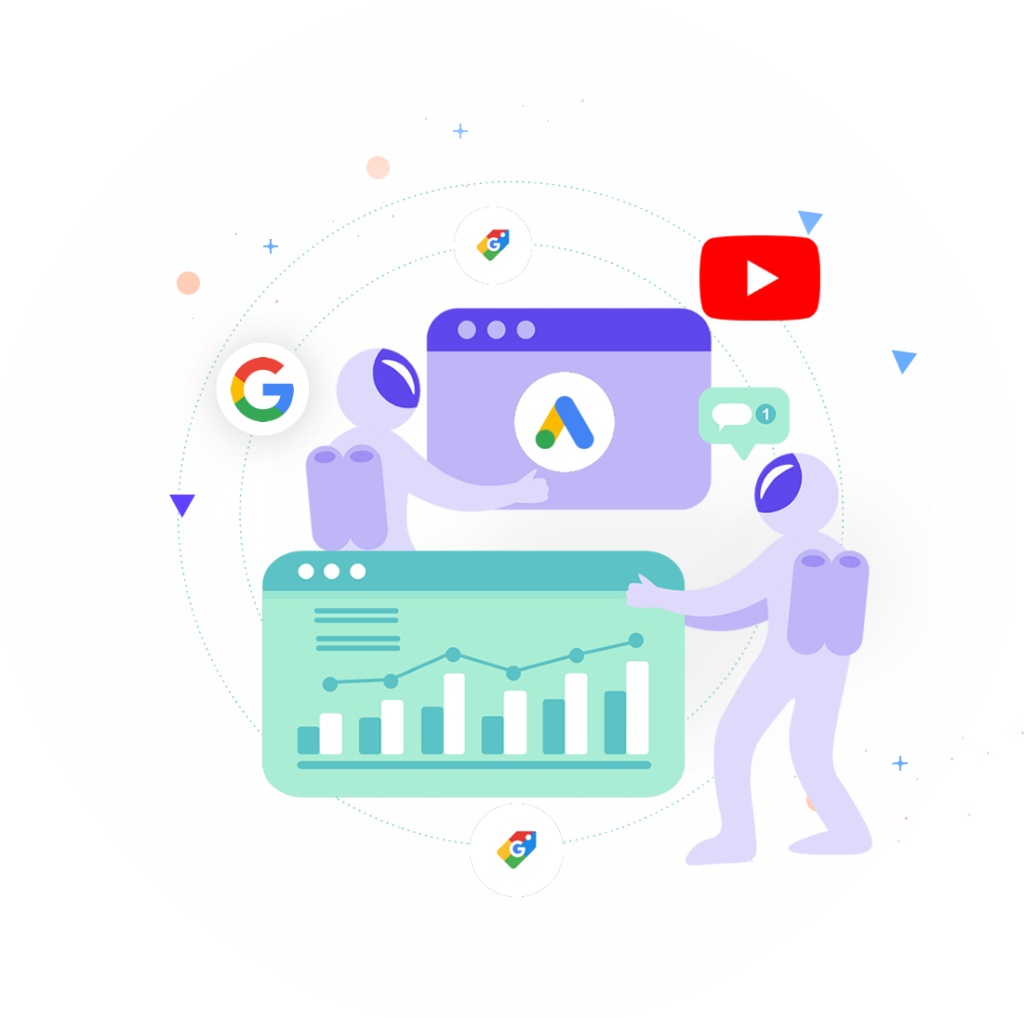
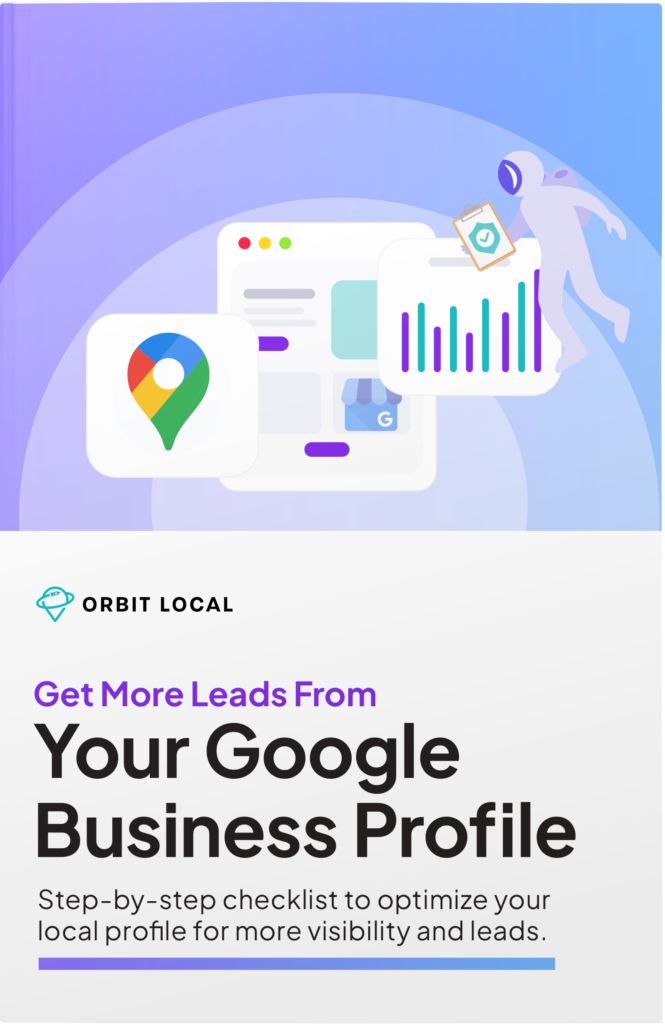

Thank you for sharing such a nice and interesting blog and really very helpful article.